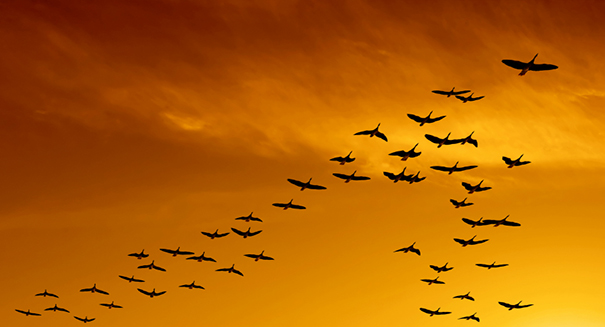
Bird formations suggest they know a lot more about aerodynamics than previously thought
It turns out that that birds might be born with more aeronautical know-how than you could ever hope to learn in a lifetime of schooling. New research out of the Royal Veterinary College suggests that birds fly in the V formation in order to strategically position themselves in aerodynamically optimum positions, and experience positive aerodynamic interactions that maximize “upwash” capture.
Using data from GPS devices on wild migrating birds, researchers discovered their formations are about more than just the appearance. Flying in certain patterns makes the birds more efficient in two ways: In the V formation, birds phase and coordinate their wing beats such that upwash (“good” air) is maximized for each individual. When flying in a straight-line formation, birds are able to minimize downwash (“bad” air) exposure, similar to how race car drivers use “drafting” to conserve power.
It was previously believed that birds were not capable of such precise engineering, mostly because scientists doubted that they possessed the capability to process the flight dynamics and sensory feedback needed to execute these efficient formations.
“The intricate mechanisms involved in V formation flight indicate remarkable awareness and ability of birds to respond to the wingpath of nearby flock-mates. Birds in V formation seem to have developed complex phasing strategies to cope with the dynamic wakes produced by flapping wings,” said Dr. Stephen Portugal, Lead Researcher at the Royal Veterinary College.
This marks the first time scientists have been able to identify the exact aerodynamic mechanisms used by free-flying birds in formation. Studies of fixed-wing aerodynamics had previously attempted to theorize the optimal positioning of birds in a V formation to maximize upwash, but these theories were inaccurate because, well, birds are not airplanes.
Still, they managed to get pretty close. In studying 14 juveniles within a flock of northern bald ibises, they found using GPS data that wing flaps occurred at an angle of, on average, 45 degrees to the bird ahead (or behind), and approximately four feet behind. That’s more or less what fixed-wing aerodynamics would predict, though Dr. Portugal noted that flocks of birds are “highly dynamic.”
In summing up the differences between V and in-line formations, Dr. Portugal had this to say:
“Birds flying in V formation flap with wingtip path coherence, meaning that their wingtips take the same path to maximise upwash capture. In contrast, birds flying in line flap in spatial antiphase, with wingtip paths maximally separated, to avoid adverse downwash.”
Leave a Reply